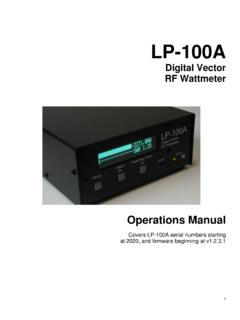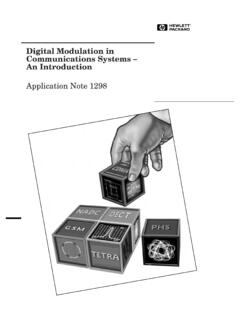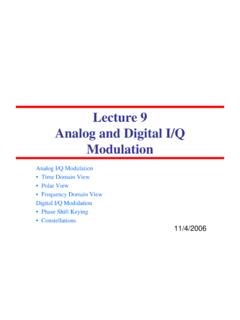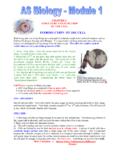Transcription of Part 6 Cranes, Hoists and Lifting Devices
1 Occupational Health and Safety Code 2009 Part 6 Explanation Guide 6-1 Part 6 Cranes, Hoists and Lifting Devices Highlights Section 59 states that this Part does not apply to drawworks on equipment that is subject to Part 37, Oil and Gas Wells. Section 63 requires employers to ensure that mobile cranes, boom trucks and tower cranes be equipped with load charts.
2 Section 64 requires operators to be competent in the use of load charts. Section 65 permits the use of electronic log books. Log books are not required for manually operated Hoists . Section 67 requires employers to develop procedures to prevent collisions during multi- crane lifts. (Section 8 of the OHS Regulation requires that procedures be in writing and available to workers.) Section 68 requires that employers provide the operator or person in charge of a lift with all the information necessary to determine the weight of the load being lifted.
3 Section establishes a requirement to conduct load calculations for lifts exceeding 75 percent of a crane s capacity. Section 69 describes restrictions on the Lifting of loads above workers. Section 89 requires employers to have load-bearing components of a mobile crane undergo non-destructive testing at 12-month intervals. Section 112 requires employers to ensure that vehicle Hoists meet the specified American National Standards Institute (ANSI) standards. Occupational Health and Safety Code 2009 Part 6 Explanation Guide 6-2 Requirements Section 59 Application Subsection 59(1) Except as described in subsection 59(4), all Lifting Devices with a rated capacity of 2000 kilograms or more are subject to the requirements of this Part.
4 A Lifting device is a device used to raise or lower materials or an object. A crane is a Lifting device that can move a load horizontally. Examples of cranes include the following: Boom-type mobile a self-propelled crane equipped with a boom and mounted on a chassis that is supported on either rubber tires, crawler treads or railway wheels running on railroad tracks. See Figure Figure Example of boom-type mobile crane Floor operated a crane that is controlled via a pendant or wireless control console by an operator on the floor or a platform independent of the crane .
5 Gantry similar to an overhead travelling crane except that the bridge for carrying the trolley or trolleys is rigidly supported on two or more movable legs running on fixed rails or other runway. See Figure o Cantilever gantry a gantry crane in which the bridge structure extends beyond the runway on one or both sides. Its runway may be either on the ground or elevated. o Portal (Whirley type) a crane that has a boom attached to a revolving crane mounted on a gantry, with the boom capable of being raised or lowered at its head outer end.
6 Portal cranes may be fixed or mobile. Occupational Health and Safety Code 2009 Part 6 Explanation Guide 6-3 o Semi-portal a portal crane mounted on a semi-gantry frame instead of a gantry frame. o Semi-gantry or single leg a gantry crane with one end of the bridge rigidly supported on one or more moveable legs, running on a fixed rail or runway, the other end of the bridge running on an elevated rail or runway.
7 O Yard crane rubber tired gantry crane . Figure Example of a gantry crane Jib a fixed crane consisting of a supported vertical member from which extends a horizontal swinging arm carrying the hoisting mechanism. See Figure o Travelling jib a jib crane with the vertical member running on a track, its upper end guided by a parallel overhead track. Figure Example of a jib crane Occupational Health and Safety Code 2009 Part 6 Explanation Guide 6-4 Overhead travelling (also known as a bridge crane ) a crane on parallel elevated runways and consisting of one or more trolleys operating from a bridge operating on the runways.
8 Operation of the travelling crane is limited to the area between the runways. See Figure Figure Example of an overhead travelling crane Pillar a fixed crane consisting of a vertical member with a revolving boom supported at the outer end by a tension member. o Pillar jib a pillar crane carrying a trolley. polar a bridge or gantry crane that travels on a circular track. Tower a crane in which a boom, swinging jib or other structural member is mounted on a vertical mast or tower. See Figure o Climber a crane erected upon and supported by a building or other structure and that may be raised or lowered to different floors or levels of the building or structure.
9 O Free-standing a crane with a horizontally swinging boom that may be on a fixed base or mounted on rails. o Mobile a crane mounted on a crawler tractor, truck or similar carrier for travel or transit. o Self-erecting truck carrier mounted and capable of self-erection. o Hammerhead a rotating, counterbalanced cantilever, equipped with one or more trolleys and supported by a pivot or turntable on a travelling or fixed tower. Occupational Health and Safety Code 2009 Part 6 Explanation Guide 6-5 Figure Example of a tower crane Wall crane a crane having a jib with or without a trolley and supported from a side wall or line of columns of a building.
10 A hoist is a Lifting device designed to lift and lower loads. Examples include: Simple drum hoist a hoist with one or more drums controlled by manual clutches, brakes or ratchet and pawl on a drum and powered by hand or electricity. Electric hoist an electrically powered, motor-driven hoist, having one or more drums or sheaves for a rope or chain. Subsection 59( ) Drawworks This subsection clarifies that drawworks used in activities and auxiliary processes associated with exploring for and drilling, operating or servicing wells for gas, crude oil or geothermal energy are covered by Part 37.



















